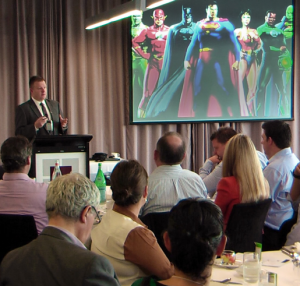
Why do we need Sales Superheroes?
This question and its answer became evident at the inaugural 12 Sales Trends Annual Business Breakfast hosted by Barrett. Focusing on what to do in light of the 12 Sales Trends for 2014 – The Thinking Sales Organisation, business and sales leaders from a wide range of industries gathered to listen to our guest speaker James Thomson, Companies & Markets editor of The Australian Financial Review and the Barrett team discuss how we can navigate our way in 2014 and beyond and stay ahead of the game by turning thinking into action.
This is the first of two articles that will summarise what was presented to a full house of engaged and interested leaders.
James Thomson presented some very important market facts we all need to take into consideration and then directed us towards the future showing us the various consequences of our actions, or inactions more importantly. Here is what he had to say:
 So what’s going on in the market place at present?
So what’s going on in the market place at present?
Some of the key take outs from his presentation:
- We shouldn’t underestimate the psychological impact of the GFC. While it was some 7-8 years ago, the economy, consumers, and businesses have not shrugged it off.
- Since the GFC we’ve seen things change dramatically. Many people have become savers and seem to value experiences over goods. The free spending ways are far behind us.
- Consumer and business confidence is bouncing wildly, accurately reflecting the mood of the market.
- Business conditions are a function of trading conditions such as profitability, sales, cash-flow, margins. It’s a decidedly mixed picture, running below zero for much of the last 18 months.
- There is a similar picture for confidence, which has actually been quite strong at times; however, there has been another turn down since the middle of last year.
- Business conditions, business confidence, and consumer confidence show certain fragility, which makes the economic picture extremely confusing at present.
Consumer Confidence
Why are consumers feeling so fragile? James pointed out that job security is always the biggest driver of poor consumer confidence.
But why are people so worried if the fundamentals are so good?
If we look at the current state of the market and employment it looks pretty good:
- Interest rates at record lows with rate rises six to 12 months off
- Unemployment at 6%
- We’re 23 months ahead on our mortgages
- House prices are rising
- Australia’s economy has been growing for 23 straight years
It’s a pretty good picture – and certainly as we’ve been told a million times before, a much better picture than in Greece or even the US. So why are we still scared of this?
James says it’s because people are smart. They do understand the underlying fragility in the economy and, more importantly, they understand how the companies they work for are really travelling. They read the news, they see the profits, but they are holding tight to ensure they can play it safe.
The best way to get a picture of how the corporate sector is travelling is through company profit results. What did the last interim reporting season teach us?
- Of the 138 companies from the ASX 200 to report half-yearly earnings, more than 65% said profits had increased – the best result since 2009-10
- In total, we saw a 19.0% lift in net profit to $36.5 billion
- Take out the big guys, profits were up 32.9%
- 50 of the 138 companies lifted their cash holdings, which rose 35% to $87 billion
- 76 companies lifted their dividends, with aggregate dividends up 7.2%.
Sounds impressive and looks positive. All that cash being held over and record profits.
BUT…
James points out that almost to a person, our CEOs are cautious; you could put some of this cautiousness down to expectation management, but our corporate leaders are reporting very lumpy conditions, poor confidence, with decisions being delayed.
So unfortunately markets remain short term focused and growth is hard to find.
Which begs the question – how are these guys producing those impressive rises in profits, those big cash piles and increasing dividends?
Cost Cutting!

Cost cutting concept illustrated with scissors cutting the word costs on blue background
The answer is that they are cutting. Cutting jobs, cutting offices, cutting plants, and cutting back on investment.
James states that in some cases, this is being forced on them not just by market conditions but also structural change in their industries – think manufacturing or media, where technology is either replacing certain tasks or just forcing businesses to restructure.
The point is, this profit growth isn’t being driven by massive sales growth, and that’s a worry.
James points out that the bigger worry is what is behind these twin trends of cost cutting on the one hand, and cash hoarding and higher dividends on the other.
He sees two reasons:
The first is that fragility of the consumer, business and markets.
The second…. The rise of the self managed super fund (SMSF)
The self managed super fund (SMSF) is such a huge trend that it is starting to have a real impact on the way these companies do business. Retirees want income to live on, so when they buy shares, they want them to come with a strong flow of dividends.
These SMSFs now account for 30% of all superannuants and that is rising. It was mentioned that as the population ages these SMSFs are likely to rise to be 50% of the superannuation market in the next few years.
Companies are being forced to listen to these SMSFs and are making decisions to keep them as investors, and attract more SMSFs on board in order to push their share prices higher.
But James’ worry is when you’re paying big dividends, what you are potentially not thinking about is…
The future!
James raises the issue: If companies are hoarding cash and increasing dividends today, is there a risk that they are not investing in the major initiatives that will deliver profit tomorrow?
While every good business has got to cut their cloth to suit their market and market conditions…
No company ever cut their way to growth.
Therefore, the question begs: What happens in 10 years when no new markets have been developed, and no great new products have been invested in?
There are some worrying signs. For instance:
The first estimate for investment in 2014-15 is $124.9 billion, down 17.4 per cent on the previous year and the biggest fall on record. (SOURCE: ABS)
So what can we do about it?
This is why we need sales superheroes.
We need our great leaders looking towards the future seeing, creating, and finding new opportunities, new markets – a diverse market place that can withstand system shocks.
We need businesses and business leaders managing costs effectively whilst simultaneously creating high functioning sales operations with salespeople out there winning new business and driving expansion that will allow investments to be made and the cycle goes on.
As James pointed out, obviously it won’t be easy, but if we boost sales, we take the focus off cost cutting as our only mandate and we create resources for investments in the future.
And that’s clearly what we need in this country – investment in great new ideas, new markets, new industries and in viable sales operations to help us move beyond mining into something even better.
Stay tuned for part 2 next week featuring how we can use the sales trends to our advantage.
You can follow James on twitter @MrJThomson
Remember everybody lives by selling something.
Author: Sue Barrett, www.barrett.com.au


New Article Email Notification